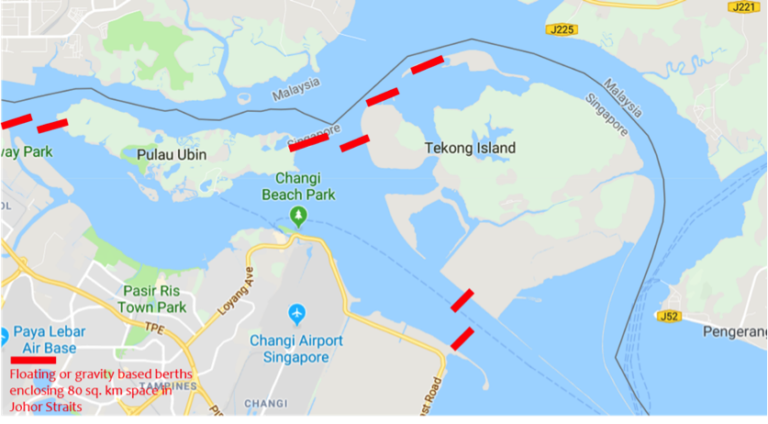President's Message
Message 16/2019
Between Malaysia and Singapore is a stretch of water, the sovereignty of which has been a bone of contention not long after the two countries went their separate ways in 1965. Reclamation is taking place on both sides of the straits placing the narrow waterway in between under ecological stress and the submarine life close to extinction.
Right now, Singapore is building an 810-ha polder at the eastern end of the Straits of Johor. At the other end, Malaysia is reclaiming four isles totalling 1400 hectares pushing Malaysia’s shoreline closer to Singapore. This tit for tat reclamation heightens tensions between the two neighbours. Singapore will not be able to win this game. It does not have the “ammunition.” Malaysia is the party with all the reclamation material necessary to win this “war.” For Singapore supplies of sand are near exhaustion. Malaysia has hills nearby that may be cut for reclamation.
Disadvantaged, Singapore needs a Plan B, a sustainable, eco-friendly and innovative one.
The figure above shows a part of the waterway in the vicinity of Changi Airport. It shows eight red rectangles strategically located just south of the common boundary. The rectangles represent large concrete caissons floated and submerged by ballast material to rest on a prepared seabed[1]. Each of the eight concrete blocks are 35 meters wide or larger and may be 200 to 500 meters in length to suit each location. The adjacent blocks are deliberately kept 100 to 200 meters apart to allow the ebb and flow of tidal currents. Depending on current velocity, tunnels may be incorporated in the caissons. Each caisson also serves as berthing facilities for yachts or patrol boats. The caissons are linked by bridges. It would therefore be possible to do a cycle trip (or a long hike) from Changi Exhibition Centre to Tekong, Ubin and ending at Serangoon Island.
The caissons are designed for a 100-year life with minimal life-cycle costs. Passing vessels will induce wakes that may cause the caissons to move. This has to be considered in the analysis and model testing during the design. The design will also consider the possibility of “dead” or unattended ships that go adrift from the laid-up anchorage in Johor River. Movements of the caisson may be digitally monitored round the clock via satellite. In the unlikely event of a displacement outside permissible limits, the caisson is deballasted and repositioned. Using remotely operated underwater camera the concrete hull can be inspected at intervals. Repairs to concrete gravity-based structures are not difficult.
How does the caisson compare with the dyke that has been proposed for Tekong?
Doubtless the caissons are more robust than the 10-km sand dyke. Even if one caisson is damaged by acts of geopolitical or terrorist hostility or collision by passing vessels, there would not be the catastrophe akin to a dyke failure. The polder requires pumping water 24×7 due to subterranean seepage. Huge pumps are needed to deal with flash floods. Outfalls are needed to discharge water safely. The enclosed water body as shown presents no such issues. The marine life on the seafloor is minimally impacted.
Have such caissons or gravity-based structure been built? Yes, in many parts of the world[2].
The enclosed area[3] is in effect a large man-made lagoon with an area about 80 sq.km. In comparison Marina Bay is 3.6 sq. km. The enclosed area is free from heavy surges, strong currents or high waves. In time it could be the world’s first fully integrated floating city, ten or more times bigger than Marina Bay complete with its own heliport for drone taxis and autonomous electric ferries that could get residents anywhere on the mainland in less time than land transport.
Is this a mere pie in the sky? No. The Dutch are experimenting with platforms with areas 3 sq. km in area. In the US floating ports more than 9 sq. km are being promoted. Our national master planners need to stay ahead of the curve. They need to keep up with floating technology and exploit its full potential. Let’s rid our dependence on sand. Let’s move out of our comfort zone.
This Society hopes the URA, HDB, MPA, EMA, JTC, NParks, NEA and any other agencies will invite us to share our ideas or to include the Society in exploratory meetings with foreign consultants that they may engage.
Tall skyscrapers are more easily built (and when old more easily disposed) than any building requiring a piled foundation. The buoyancy of water is more dependable and predictable than the skin friction of piles or the bearing capacity of soil. Skyscrapers can be built using methodologies proven in rig building by preassembling large blocks on ground and lifting with floating cranes. These methods are fast and efficient.
It is worth noting that the heaviest man-made structure is not sitting on land but floating in water. The tallest building that could be floating could be higher than the Burj Khalifa. A Japanese contractor is promoting a floating eco-city towering 1000 meters above the sea for a population of 30,000 people. The test basin at TCOMS based at the National University of Singapore is ideally suited to perform tests on the impact of waves, and currents on the stability of the floating structures.
The plans to develop Tekong as a base for military training will not be compromised. Instead of bases on land below the sea level, the base will be built on floating structures[4]. The risk of inundation of the base due to a dyke breach or rising sea level does not arise in the floating option.
West of the Johor Causeway in the straits, opportunities abound to use floating solutions to create space for vertical farming, water sports and holiday resorts without seriously damaging the coastal ecology.
Lim Soon Heng
12 Jan 2019
[1] Other mooring arrangements are possible but are not discussed here for sake of brevity. For those interested google mooring systems in offshore structures
[2] The berths of the mega port at Tuas is employing similar technology. Monaco has s similar structure which was constructed in and towed from Spain.
[3] The shipyards and power station upstream need to be relocated. Options are available.
[4] A paper will be presented by me that cover the topic of floating army, air and naval bases in April 2019 at the World Conference on Floating Solutions at the NUS.


